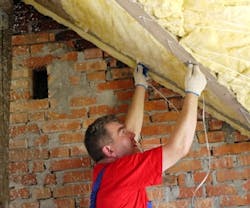Understanding the R- and U-Values of Insulation
Improved insulation is a good step toward improving building efficiency, particularly since the Atlanta-based American Society of Heating, Refrigerating and Air-Conditioning Engineers (ASHRAE) increased minimum roof-insulation levels in 2007 in its Standard 90.1—the first increase in 18 years. And, if that isn't enough to spur someone into action: A recent McKinsey & Co. report named insulation as the single most cost-effective way to improve energy efficiency based on cost comparison per square foot.
A standardized insulation rating system ensures consistency, with insulating materials rated in R- and U-values. R-values represent resistance to the flow of heat; the higher the R-value, the greater the resistance and the insulating value. U-values are the direct opposite, representing the amount of heat that escapes through a material. The lower the U-value, the slower the rate of heat flow and the better the insulating quality.
Ultimately selecting which product and value to use depends on many factors - particularly thermal load; regardless, ASHRAE's new above-deck roof insulation standard is a good place to start, as it jumped 33 percent, from R-15 to R-20, in five of six climatic regions. "This standard is not a requirement to retrofit—it's a guideline—but it can become one if a state adopts it as a building code," explains Jeff Harris, vice president for programs at the Alliance to Save Energy, Washington, D.C. "Standards should be considered for new builds and major renovations—any time you have a reasonable opportunity to add insulation, you should."
Still, that doesn't necessarily mean that more insulation is better. Although R-value is proportional to insulation thickness, it also depends on the type of material and its density. The more air pockets in an insulating product, the higher the R-value.
"Glass façades are the perfect example of aesthetics colliding with physics," explains Paul Bertram, director of environment and sustainability for the North American Insulation Manufacturers Association, Alexandria, VA. "You can attain efficiencies, but there are tradeoffs. Regardless of a building's design, the answer isn't stuffing in as much insulation as you can; you'll reach a point of diminishing return. Coordination between all building systems is a leading indicator of energy efficiency, and optimizing that integration can best be achieved when architects and engineers work as a team. Proper installation is also as important as the product you're using."
| Rated R-Value and Thickness of Insulation* | |||||||||||||
|
R-Value |
R6 | R11 | R13 | R15 | R19 | R21 | R22 | R25 | R30 (C**) | R30 | R38 (C**) | R38 | |
|
Insulation Thickness |
1.75" | 2.5" | 3.5" | 3.5" | 3.5" | 6.25" | 5.5" | 6.5" | 8" | 8.5" | 10" | 10" | 12" |
|
* All listed thicknesses are approximate and may vary by +/- 0.5 inches. |
|||||||||||||
|
** The "C" denotes high-density materials specifically designed for installation in areas where space is limited, such as cathedral ceilings. |
|||||||||||||
Stephanie J. Oppenheimer, former assistant vice president of communications at BOMA Intl., is principal at Skylite Communications, based in Falls Church, VA.
